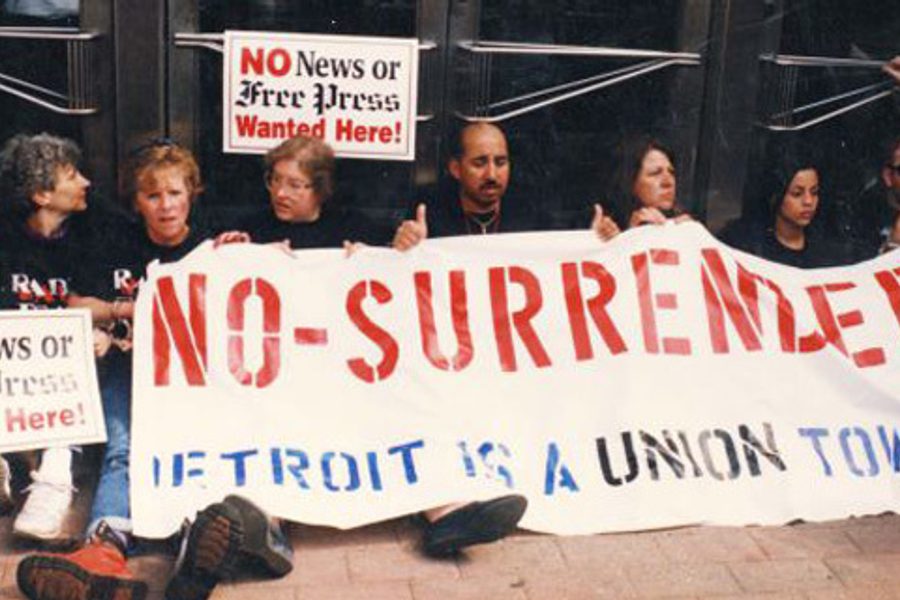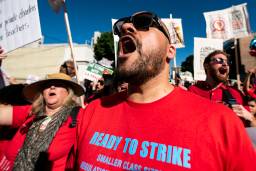
In the mid-1990s, 2,500 newspaper workers at the Detroit News and the Detroit Free Press engaged in a heroic, high-profile strike against the Gannett and Knight-Ridder newspaper chains. In a five-year battle, workers threw a wide array of tactics against the employer, including a very effective local boycott, a corporate campaign, and extensive unfair labor practice charges. Yet sadly, the strike did not end in a union victory.
Chris Rhomberg, a sociology professor at Fordham University, chronicles the strike in the recently published The Broken Table: The Detroit Newspaper Strike and the State of American Labor. Be prepared: This is not a feel-good story. Rhomberg uses the newspaper strike to reveal all that is wrong with the modern system of collective bargaining and striking.
As he writes in the introduction, his book “is addressed to all readers concerned about the future of workplace governance in the United States.” The title of the book refers to how employers have wrecked the collective bargaining table by locking out workers and triggering strikes. As Rhomberg states, “Deliberately negotiating to impasse, unilaterally imposing conditions, and breaking strikes — all of these actions destroy the function of collective bargaining…” With lockouts and employer-provoked strikes on the rise, The Broken Table offers a timely message.
For those not familiar with the Detroit newspaper strike, Detroit News and the Detroit Free Press workers were forced out on strike in 1995 by a management team hell-bent on crushing the newspaper guild union. “The strike was fundamentally not about traditional dollars and cents, but about the control of the workplace and the future of the bargaining relationship,” Rhomberg writes.
By his account, the newspapers were far better prepared for battle than the striking workers. They prepared for the strike for years, engaged in bargaining tactics calculated to provoke a strike, and put in place extensive contingency plans.
Workers engaged in a wide variety of tactics to attempt to win. Strikers set up their own newspaper, The Detroit Sunday Journal, which in its first year had 300,000 subscribers. A vigorous local boycott caused circulation at the struck newspapers to drop precipitously, resulting in an estimated $100 million loss for the papers in the first six months of the strike. But the boycott didn’t force the employers to settle; the massive national newspaper chains had deep enough pockets to ride out the strike.
Despite widespread community support and internal solidarity, the companies had the upper hand. The newspapers aggressively hired permanent replacement scabs and spent an estimated $40 million spent on private security, the employers paid another $1 million to buy off the suburban Sterling Heights police force where the production plant was located. When mass picketing at the plant threatened to block production, police responded with brutality. Judges sided with employers, enjoining the union.
“On February 14, 1997, after 19 months on strike, unions made an unconditional offer to return to work,” Rhomberg writes. “But employers announced that they would take back only a fraction of the striking workers, as new vacancies allowed.” Legal challenges, upon which the unions’ hopes of strike success hinged, failed to stick. Although the National Labor Relations ruled in 1997 that the employer had engaged in unfair labor practices, federal judges undercut the independent agency and upheld the newspapers in 2000, forcing the unions to agree to contracts on management’s terms.
The Broken Table explains the incredible odds these striking workers faced. For one, workers were attempting to strike one part of a national newspaper chain. Rhomberg explains in great detail the transformation of the newspaper industry from a locally run operation to an industry dominated by national mega news chains. This is a theme in many of the failed strikes of recent decades, where isolated local unions struck against massive national chains. In contrast, in the period following World War II, unions would take on entire industries with hundreds of thousands of workers striking at once.
Striking workers also faced the power of the government, which consistently backed the company throughout the strike. As Rhomberg meticulously documents, well in advance of the strike the Sterling Heights police department and the newspapers were jointly developing strike contingency plans.
The Broken Table does not offer advice or analysis on how the outcome could have been different. In fact, the book pays relatively little attention to the corporate campaign and road warriors, which was my point of interaction with the strike. In the late 1990s, striking workers crisscrossed the country to draw attention to the conflict and put pressure on corporate boards of directors. Rather, the book zeros in on the decline of the modern system of bargaining.
Indeed, in both the public and private sectors, that system is in crisis. In recent years employers — including profitable companies and cash-strapped governments — have launched renewed offensives against collective bargaining rights, and aggressively pushed concessionary contract proposals. To name just two examples, more than 100,000 workers at Verizon and AT&T are fighting for good contracts with profitable employers, while Wisconsin public-sector unionists are in the fight of their life to recall anti-union Gov. Scott Walker. In case after case, employers have locked out workers, including sugar workers in Fargo, N.D.
The Broken Table fits takes its place within a genre of books that chronicles lost strikes. This genre details key efforts of workers to confront capital’s offensive, including the air traffic controllers strike, the Phelps Dodge mining strike, the meatpackers strike at Hormel, the Paperworkers in Jay, Maine, and the Staley struggle in the war zone of Decatur, Ill. All of these struggles ended in failure for labor, but that doesn’t mean activists shouldn’t study them.
What can they teach us? For some, the lesson of these books is that we should give up — that strikes cannot be won and attempting to survive is our only option. I hope that others will reach different conclusions after reading The Broken Table and books of its ilk: collective bargaining rights must be defended, and trade unionists must begin to create new forms of effective strike activity.
But on a deeper level, stories of failed strikes have intrinsic value. Brave people fought against the odds, showed tremendous courage, experimented with new tactics, and in many cases, were transformed as activists and as people. We need to hear their stories. By pushing back, these striking workers revealed what does not work and why.
Labor history is littered with defeats that sowed the seeds of victory for workers. By learning lessons, fighting smarter, and, most important, challenging illegitimate legal restrictions on the right to strike, our ancestors built a powerful labor movement capable of transforming society. It is still possible.
Joe Burns, a former local union president active in strike solidarity, is a labor negotiator and attorney. He is the author of the book Reviving the Strike: How Working People Can Regain Power and Transform America (IG Publishing, 2011).







